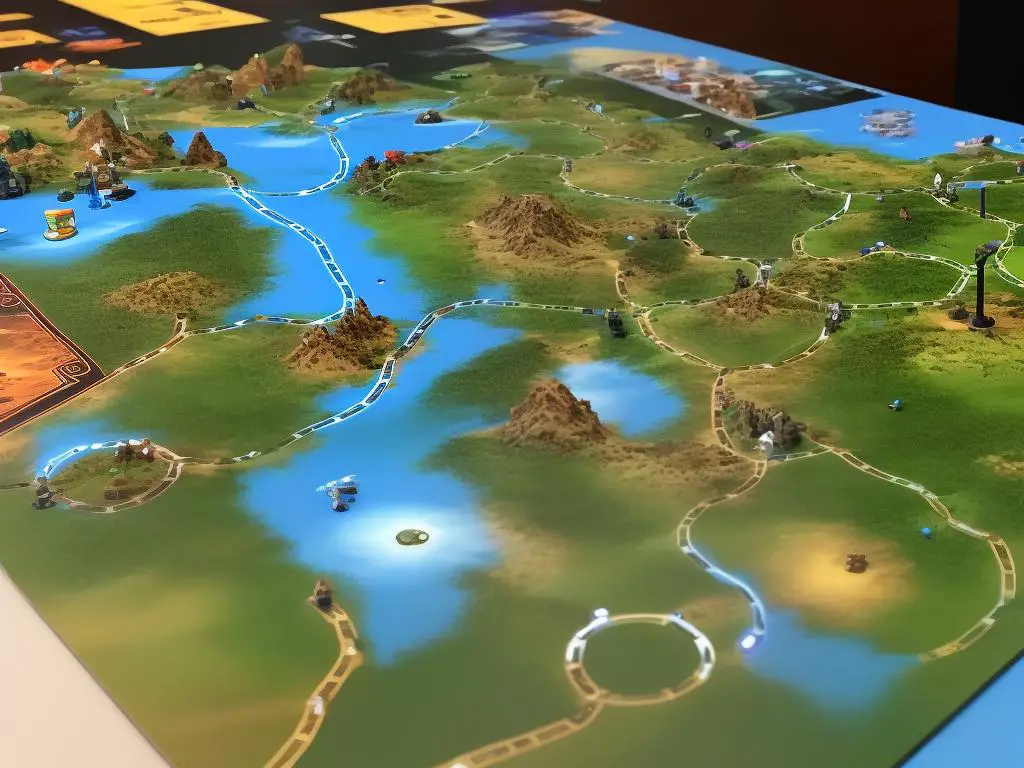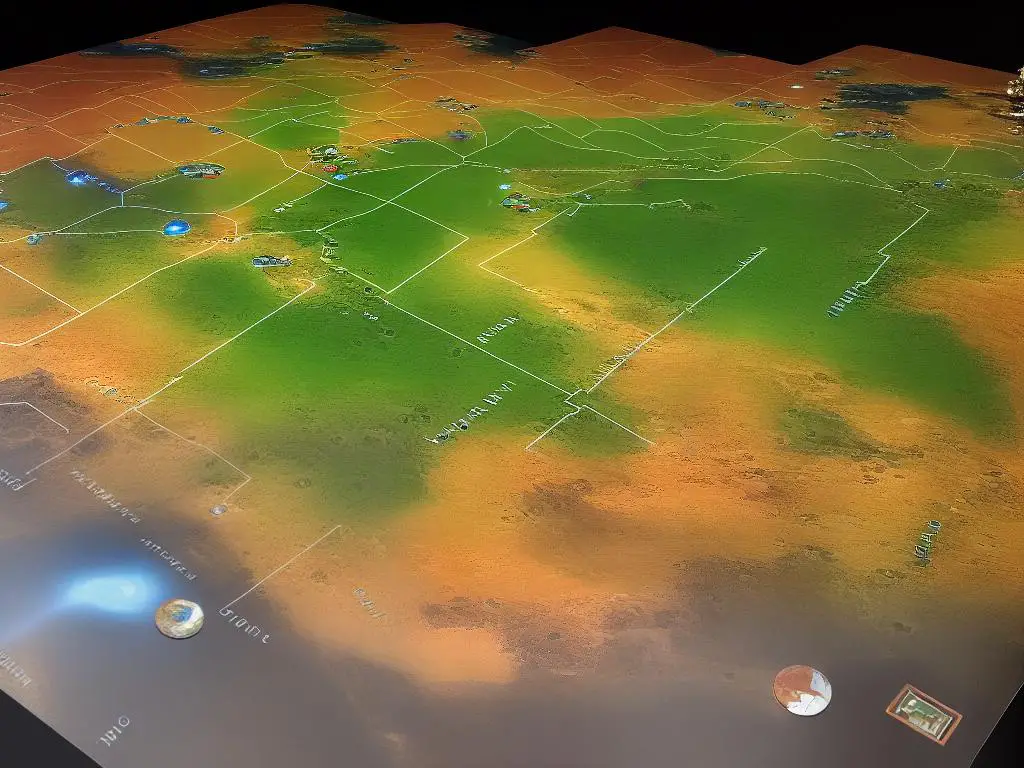The fascinating prospect of terraforming Mars has captured the imagination of both scientists and game enthusiasts alike. Terraforming Mars, a highly-engaging strategy board game, allows players to embark on an immersive journey towards transforming the Red Planet into a habitable environment for human colonization. This essay will provide an overview of the game mechanics, components, and setup, while also discussing the essential aspects of gameplay, strategies, and expansions that contribute to making the game rich, captivating, and above all, challenging.
Game Overview
Game Overview
Terraforming Mars is a strategy board game designed by Jacob Fryxelius and published by FryxGames in 2016. The game’s premise is set in the 2400s when Earth’s technology is advanced enough to initiate the terraforming process on Mars. Players take charge of different corporations working together, yet competing to make Mars a liveable planet by increasing its oxygen level, raising the temperature, and creating oceans. All while managing resources, investing in projects, and vying for victory points to be crowned the most successful corporation at the end of the game.
Game Objectives
The primary goal of Terraforming Mars is to turn the Red Planet into a habitable environment for human colonization. Players achieve this by completing three main terraforming tasks: increasing the planet’s temperature, increasing its oxygen levels, and placing ocean tiles on the board. These actions represent the required changes to Mars’ harsh environment to make it suitable for human life. As players progress through terraforming actions and various projects, they accumulate victory points (referred to as Terraform Rating or TR) that determine their overall success at the completion of the game.
Gameplay
In Terraforming Mars, a strategy board game designed by Jacob Fryxelius, players assume the roles of unique corporations with specific advantages and starting resources. These corporations collaborate to terraform Mars, vying to accumulate the most victory points in the process. The resources at their disposal include MegaCredits (the game’s currency), steel, titanium, plants, energy, and heat. The game board represents Mars, providing various areas for placing tiles such as cities, greenery, and oceans to facilitate the terraforming process.
Played over multiple rounds or generations, each player performs an array of actions during their turn in each generation. Players can engage in activities such as:
- Playing project cards
- Using their corporation’s unique actions
- Utilizing standard projects provided on the board
- Converting plants into greenery tiles (increasing oxygen levels)
- Converting heat into temperature increases
- Claiming a milestone or funding an award

Game Components and Setup
Project Cards and Strategy
Project cards play a crucial role in advancing in Terraforming Mars, enabling players to enhance their corporation’s capabilities, improve resource production, create unique effects, and establish special actions. The cards come in three main types: Event, Automatic, and Active. Event cards, used only once, produce an immediate effect; Automatic cards grant ongoing effects or actions available each turn, and Active cards require activation for their effects, usually involving the use of resources or meeting specific requirements.
Effective resource management, strategic investments in synergistic projects, and timely execution of actions determine success in Terraforming Mars. While working towards transforming the planet, players must also anticipate potential setbacks from rival corporations and the harsh Martian environment.
As the game progresses, players collectively advance Mars’ terraforming process by raising its temperature, introducing plant life, and creating ocean habitats. The game concludes once all three terraforming conditions are met: the temperature reaches +8°C, oxygen levels hit 14%, and all nine ocean tiles are placed. The player who garners the most victory points through their Terraform Rating, project cards, and tiles on the board is declared the winner, emerging as the most successful corporation in terraforming Mars.
Game Components
The game components of Terraforming Mars include:
- Game Board: The central playing area where players will be placing tiles and marking global parameters such as temperature and oxygen levels.
- Player Boards: Individual boards for each player representing their corporation, where they will track their production and resource levels.
- Cards: There are three types of cards – project cards, corporation cards, and global event cards. Project cards represent different actions players can take to terraform Mars, while corporation cards determine each player’s starting resources and unique abilities. Global event cards are optional and add to the game’s complexity.
- Tiles: There are several types of tiles used in the game, including ocean, greenery, and city tiles, as well as special tiles with unique effects.
- Resource Cubes: Resources are represented by small cubes in three different sizes – small (1 resource), medium (5 resources), and large (10 resources). Resources include mega credits (money), steel, titanium, plants, energy, and heat.
Game Setup
To begin preparing the Terraforming Mars board game, follow these steps:
- Position the game board in the center of the table.
- Place the temperature and oxygen level markers at their starting positions (-30°C and 0% oxygen) on the game board.
- Set ocean tiles next to the game board, face down, and shuffle the stack of greenery and city tiles, also placing them face down.
- Each player chooses a color and takes the corresponding player board, resource cubes, and a set of markers for tracking production levels, remaining terraforming actions, and victory points.
- Players each receive a corporation card – either the default beginner corporation or a random corporation card for more advanced games. Next, players reveal their corporation cards and place their resource cubes according to the specified starting resources and production levels.
- Shuffle the project cards and deal 10 to each player.
- Each player decides which project cards they want to keep in their starting hand, paying 3 mega credits for each card retained and discarding the rest.
- Position the generation marker on the first space of the generation track. Players also place a terraforming handicap marker on the terraforming rating scale, typically starting at 20 but adjusted as needed to balance the game.
Once the setup is finished, players can commence the game, taking turns executing actions like playing cards, using standard projects, converting plants into greenery, or spending heat to increase the temperature. Throughout the game, players must carefully manage their resources and production levels to optimize their terraforming and victory point potential. The game concludes when all three global parameters have been maxed out – all ocean tiles placed, the oxygen level reaches 14%, and the temperature reaches 8°C. Finally, scores are calculated, and the player with the most victory points is declared the winner of Terraforming Mars.

Playing the Game: Actions and Phases
Game Overview
Terraforming Mars is an engaging board game for 1-5 players that was designed by Jacob Fryxelius and published by FryxGames and Stronghold Games in 2016. Set in the 24th century, players assume the roles of rival corporations striving to make Mars habitable for human life. This is accomplished by increasing the planet’s temperature, oxygen levels, and creating oceans, all while developing projects, constructing infrastructure, and mining resources.
Starting the Game
At the start of the game, each player receives a corporation card, which provides a unique power and starting resources. Players also draw ten project cards and can choose to keep some, paying three MegaCredits (MC) for each card retained. The game board represents Mars and its various potential developments, including the placement of cities, greenery, ocean tiles, and special tiles.
Player Turns and Actions
Gameplay is divided into generations, which represent the passage of time. Each generation consists of four phases: player order, research, action, and production.
During the player order phase, players determine the first player for the current generation. In the research phase, players draw four project cards and choose which to keep, paying three MC for each retained card.
In the action phase, players take turns executing one or two actions. There are several actions to choose from, including:
- Playing a project card from their hand. Project cards can represent new technologies, buildings, or events, which modify gameplay in various ways. To play a card, players pay its cost in MC and meet any required conditions, such as specific temperature, oxygen, or ocean levels.
- Using a standard project, which represents broader actions that any corporation can take. Standard projects include raising the planet’s temperature, increasing oxygen levels, creating oceans, building cities, or planting greenery. Each standard project has a specific MC cost and may directly impact the planet’s terraforming parameters.
- Converting plant resources into greenery tiles, which players place on the board and increase oxygen levels.
- Claiming a Milestone or Funding an Award. Milestones and Awards are bonus-scoring objectives tied to various accomplishments in the game, such as building a certain number of cities or having the highest terraform rating. Each Milestone or Award can only be claimed by one player and cost MC to claim.
- Using an action on one of their previously played cards. Some project cards have an action that can be activated by spending resources or a specific condition.
Players continue to take turns until all players have passed, signifying they have no more actions to take in that generation.
Production Phase
During the production phase, players generate resources based on the production levels of their corporations. These resources include MegaCredits, Steel, Titanium, Plants, Energy, and Heat. Energy produced in one generation is converted to Heat during the production phase, further contributing to the planet’s temperature increase.
Players use these resources throughout the game to play project cards, engage in standard projects, and activate abilities tied to their corporations or played cards.
Terraforming Parameters and Game End
In Terraforming Mars, players represent corporations working together to terraform the Red Planet. The primary objective is to manage the three main terraforming parameters: Temperature, Oxygen, and Oceans. Throughout the game, players perform actions that modify these parameters, while simultaneously increasing their Terraform Rating (TR). The TR is a measure of a corporation’s contribution to Mars’ terraformation and serves as the primary scoring mechanism and in-game currency.
Once all three terraforming parameters are maxed out – 14% oxygen, 8°C temperature, and all nine ocean tiles are placed on the board – the game ends at the conclusion of that generation. Players then tally up their victory points from their TR, claimed Milestones, funded Awards, and any victory points awarded by project cards. The player with the highest total victory points wins the game.

Photo by jannerboy62 on Unsplash
Scoring and Winning the Game
Scoring in Terraforming Mars
Throughout the game, players compete to earn the highest Terraform Rating (TR) by actively contributing to the terraformation process on Mars. They can increase their TR by performing various actions such as raising the oxygen level, increasing the temperature, and placing ocean tiles on Mars. Additionally, players can accumulate Victory Points (VP) through other means like constructing cities, planting forests, and gathering resources.
Players start with an initial TR of 20, and it increases as they contribute to terraformation. At the end of the game, a player’s final score is calculated by adding their TR to their total VP earned. It is crucial to monitor both your TR and VP throughout the game, as they will ultimately determine the winner. As players focus on improving the planet’s terraforming parameters, they must also be strategic in maximizing their TR and VP for the best chance of victory.
Victory Points and Milestones
Aside from the TR, players can earn Victory Points in various ways, including:
- Playing cards: Certain cards in the game grant VP when played. Card abilities often provide immediate or end-game benefits, such as bonuses based on the player’s board position or resources.
- Building cities and forests: Placing city tiles grants 1 VP for each adjacent forest tile, while each forest tile is worth 1 VP.
- Milestones and Awards: Players can claim Milestones and fund Awards by meeting specific criteria during the game, such as owning a certain number of city tiles or amassing a particular resource. Milestones grant a flat 5 VP, while Awards grant 5 VP to the player that meets the criteria at a higher level and 2 VP to the second-place player.
- End game bonuses: Some cards and actions provide end-game bonuses in the form of VPs.
End Game Conditions
Terraforming Mars ends when three specific terraforming conditions are met: The oxygen level reaches 14%, the temperature reaches +8°C, and all nine ocean tiles have been placed on the board. When this happens, the current generation (round) is completed, and players proceed to the production phase. After the production phase, players enter the final scoring phase, where they add any unaccounted Victory Points to their total score.
Determining the Winner
Terraforming Mars is a competitive, strategic board game that sees players vying for supremacy in transforming the inhospitable environment of Mars into a habitable planet. Throughout the game, players will accumulate Victory Points and increase their Terraform Rating (TR), reflecting their contributions to the terraforming process. Once the three main objectives, namely increasing the oxygen level, raising the temperature and placing all ocean tiles, have been achieved, the game concludes, and all Victory Points are tallied. The player with the highest combined TR and Victory Points is declared the winner. In case of a tie, the tied players compare their resources (adding MegaCredits to all other resource types), and the player with the higher total wins. If there is still a tie, both players share the victory. Becoming a master terraformer requires understanding the scoring system, long-term planning, and efficient resource management in order to outlast your opponents in the race to shape the red planet.

Strategies and Expansions
Strategies and Expanding the Game
Terraforming Mars offers players a variety of strategic avenues for achieving victory, including increasing production, generating resources, and completing planet-altering projects. To outscore opponents, players must balance short-term goals with long-term planning, starting with increasing basic resource production in the early stages of the game. As the game progresses, players should shift their focus to projects that contribute directly to Mars’ terraformation, and also remain adaptable to the game’s dynamic environment.
For even more variety and strategic depth, Terraforming Mars can be expanded upon with four primary expansions: Prelude, Venus Next, Colonies, and Turmoil. Prelude introduces new corporation backgrounds that give players unique starting abilities and bonuses, while Venus Next explores the terraforming process on Venus via a new board, cards, and the cooperative World Government. Colonies adds outposts throughout the outer solar system for additional resource gains and strategic options. Finally, the Turmoil expansion injects politics into the game, with players grappling for influence over a new Terraforming Committee board representing various political parties.

Indeed, Terraforming Mars is a thrilling and thought-provoking game that requires astute strategies to achieve the ultimate objective of making Mars habitable. By grasping the complexities of the game’s mechanics, players can unleash their inner pioneer and outsmart their opponents in the race to colonize Mars. As this essay has demonstrated, understanding the workings of Terraforming Mars can lead to a more gratifying gaming experience and open up a world of wonders that only a successful Mars terraforming endeavor can offer. Engage in the thrill of the challenge and the joy of mastering this game, for it might help us imagine solutions for future space colonization endeavors.